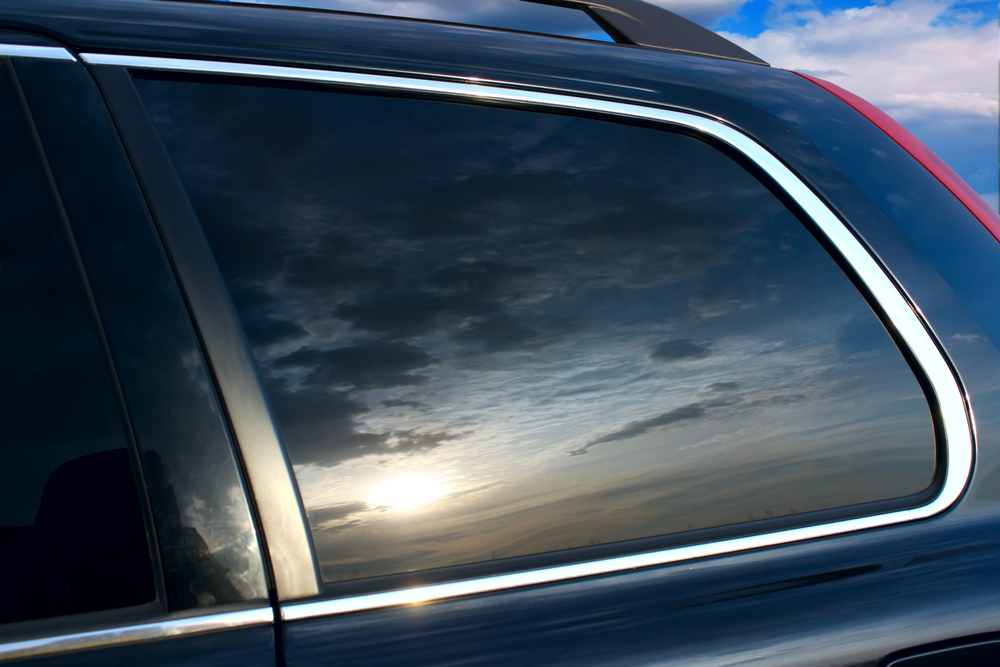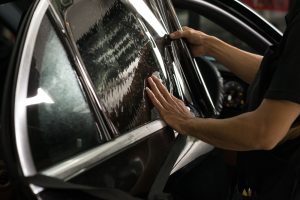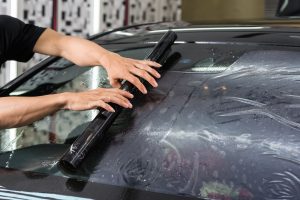
Car window tinting is a common aftermarket modification. You can see tinted windows on both tuned sports cars or luxurious sedans, as well as on SUVs or family cars. Although aesthetic appeal is something highly subjective, hardly anybody could deny that cars with tinted windows look better. But is it all down just to the visual appearance, or are there other perks that come with it? In this article, we will go through the purposes of window tint, covering all pros and cons that come with it.
Why should you get your windows tinted?

Having your windows tinted brings many noticeable advantages. For a start, as the tinting film has a reflective surface, it will block off a certain amount of heat radiation from entering your vehicle. Therefore, many argue that tinted windows will keep your car cooler on hot sunny days. Not only that this makes your trip more comfortable, but it also protects the interior of your car from damage caused by excessive heat. Additionally, it is hard to see inside the car when windows are dark. This helps increase both privacy and safety, as it keeps prying eyes away and deters potential thieves.
However, the biggest advantage of tinted windows is an added layer of UV protection. While heat or privacy are more of a comfort issue, ultraviolet radiation is a serious health issue that must not be discarded. Although laminated glass used for windscreens blocks almost all UV radiation, tempered glass blocks only about 20 percent of harmful damaging UVA radiation. And this is the glass used for side windows and the rear screen on most cars.
Is tinting car windows a good idea?

You may wonder if you should tint your car windows, or if there are reasons not to tint car windows. To answer these questions, we must go over some basics about car window tinting.
The first thing to consider is that not all window tints are the same. As there are many manufacturers on the market with a wide range of films available, it is hard to differentiate good films from poor quality ones. With cheap or poorly installed films, your windows will gradually fade and turn purple with time. In the worst case, it will bubble as the adhesive gives way. To avoid this, do your research and find a reputable foil installer who uses premium products.
Second, know that there are different types of film on the market. We can divide these into three main types: dyed film, metallized film and ceramic film. Dyed film is a basic entry-level product that can help block some sunlight and get more aesthetic look appeal to the vehicle. Metallized film has a metallised layer, which is great for blocking heat transfer. However, it has some disadvantages. One of them is a high reflection mirror, which can make it illegal in some states. Also, it can interfere with radio and cell phone signals. Lastly, we have ceramic films. These have the same infrared heat reduction that comes with a metallised film without the signal here interference. And it matches well to the vehicle factory tint. Although more expensive, ceramic window tint benefits justify this extra cost.
Lastly, Laws regarding car window tinting is another important aspect to consider. One important regulation related term is ‘Visible Light Transmission’ or VLT. This is a number that will tell you how much light will go through the film. For example, a 35 percent VLT film will block 65 percent of the visible light. Minimum allowed VLT differs from state to state. And, in most cases, regulations allow higher VLT on windows behind the driver. Additionally, windscreens must not be tinted in any way, not even with a clear film, except in a strip up the top.
Does window tinting make your car cooler?

This is one of those debate triggering questions that last forever. Look it up on the Internet, and you will find an equal amount of arguments and explanations for both claims. And the definitive answer is that it makes your car cooler, but only in a short run. Leave your car sitting in the sun for a whole day, and it will not be much cooler on the inside than any other car.
Still, this does not mean there are no substantial benefits from window tints when it comes to keeping your car cooled down. Tinted windows reduce the amount of heat that enters your car. The temperature inside of your car will go up at a slower rate than it would if windows were untinted. Combine that with a windshield sun shade, and you could keep interior temperatures at acceptable levels for quite a long time. Lastly, without exposure to direct sunlight, parts such as a steering wheel, gear lever, or door handles will not be flaming-hot. You will value this when your fingers remain unburnt.
How much does car window tinting cost?

Depending on where you ask, prices for tinting a whole car can range anywhere from $100 to more than $450. As this is a big difference, we will go over some things that make that difference in determining the price. Obviously, one of the factors will be the used type of film. With different manufacturers and film types, either died or ceramic, this can have a significant impact on the overall cost of window tinting. Another thing to consider is the type and size of the car. Tinting windows on a big SUV will take much more time and film than it would on a small hatchback. Lastly, if you are looking for a high quality of service and factory level of detail, remember this will come at a higher price.
One more tip: do not get the dealership to tint the windows for you, as they will outsource this job. Chances are they will use the same tinting workshop as you would. The only real difference is it will cost you much more.
How long does window tint last on a car?
Just like with anything else on your car, the window tint longevity will vary based a number of factors. As the film quality and a proper fitment combination have the most significant life-span impact, this is no place for cutting corners. Application in certain weather conditions play another significant role, as both boil and adhesive deteriorate under exposure to extreme heat. Lastly, even though window tints are essentially maintenance-free, cleaning with water and a mild soap will help make them last longer. Thus, car window tints can deteriorate in less than 2 years in case of low quality and poorly fitted films. On the other hand, if the fitter uses premium products and great attention to details, you can expect tints to last over 10 years.
Additionally, try finding out what kind of warranty comes with the film. Find ones that have a lifetime warranty against any peeling fading or bubbling. Some films even come with a lifetime warranty and with a one-time no-fault warranty. This means that if your window tint gets damaged from any reason, your installer will replace it for free.
